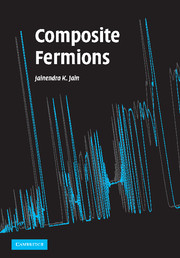Book contents
- Frontmatter
- Contents
- Preface
- List of symbols and abbreviations
- 1 Overview
- 2 Quantum Hall effect
- 3 Landau levels
- 4 Theory of the IQHE
- 5 Foundations of the composite fermion theory
- 6 Microscopic verifications
- 7 Theory of the FQHE
- 8 Incompressible ground states and their excitations
- 9 Topology and quantizations
- 10 Composite fermion Fermi sea
- 11 Composite fermions with spin
- 12 Non-composite fermion approaches
- 13 Bilayer FQHE
- 14 Edge physics
- 15 Composite fermion crystals
- Appendixes
- References
- Index
14 - Edge physics
Published online by Cambridge University Press: 07 December 2009
- Frontmatter
- Contents
- Preface
- List of symbols and abbreviations
- 1 Overview
- 2 Quantum Hall effect
- 3 Landau levels
- 4 Theory of the IQHE
- 5 Foundations of the composite fermion theory
- 6 Microscopic verifications
- 7 Theory of the FQHE
- 8 Incompressible ground states and their excitations
- 9 Topology and quantizations
- 10 Composite fermion Fermi sea
- 11 Composite fermions with spin
- 12 Non-composite fermion approaches
- 13 Bilayer FQHE
- 14 Edge physics
- 15 Composite fermion crystals
- Appendixes
- References
- Index
Summary
Let us consider fully spin-polarized electrons in one dimension. Because of the Pauli principle, each electron is confined inside a box marked by its two neighbors on either side. As an electron moves, it collides with the neighboring electrons and, through a two-way domino effect, the dynamics becomes collective. (This is to be contrasted with higher dimensions where electrons can budge sideways to make way for a moving electron.) Electron-like quasiparticles are no longer well defined in one dimension, resulting in a breakdown of Landau's Fermi liquid theory. An understanding of the effect of interactions requires a nonperturbative treatment. Interacting liquids in one dimension are called Tomonaga–Luttinger (TL) liquids. We see in this chapter that the FQHE edge constitutes a realization of a Tomonaga–Luttinger liquid. (Certain organic or blue bronze type conductors have stacks of weakly coupled 1D chains, which behave as independent 1D conductors at high temperatures, when the coupling is irrelevant, but become three dimensional at low temperatures.)
QHE edge = 1D system
We have learned that excitations cost a nonzero energy in a pure QHE system. That is indeed true for the spherical samples of computer experiments, but not quite true for a sample in the laboratory. Excitations with arbitrarily low energies are available at the boundary of a QHE system. The dynamics of these excitations is equivalent to that of a one-dimensional system.
- Type
- Chapter
- Information
- Composite Fermions , pp. 413 - 441Publisher: Cambridge University PressPrint publication year: 2007

